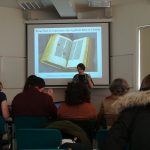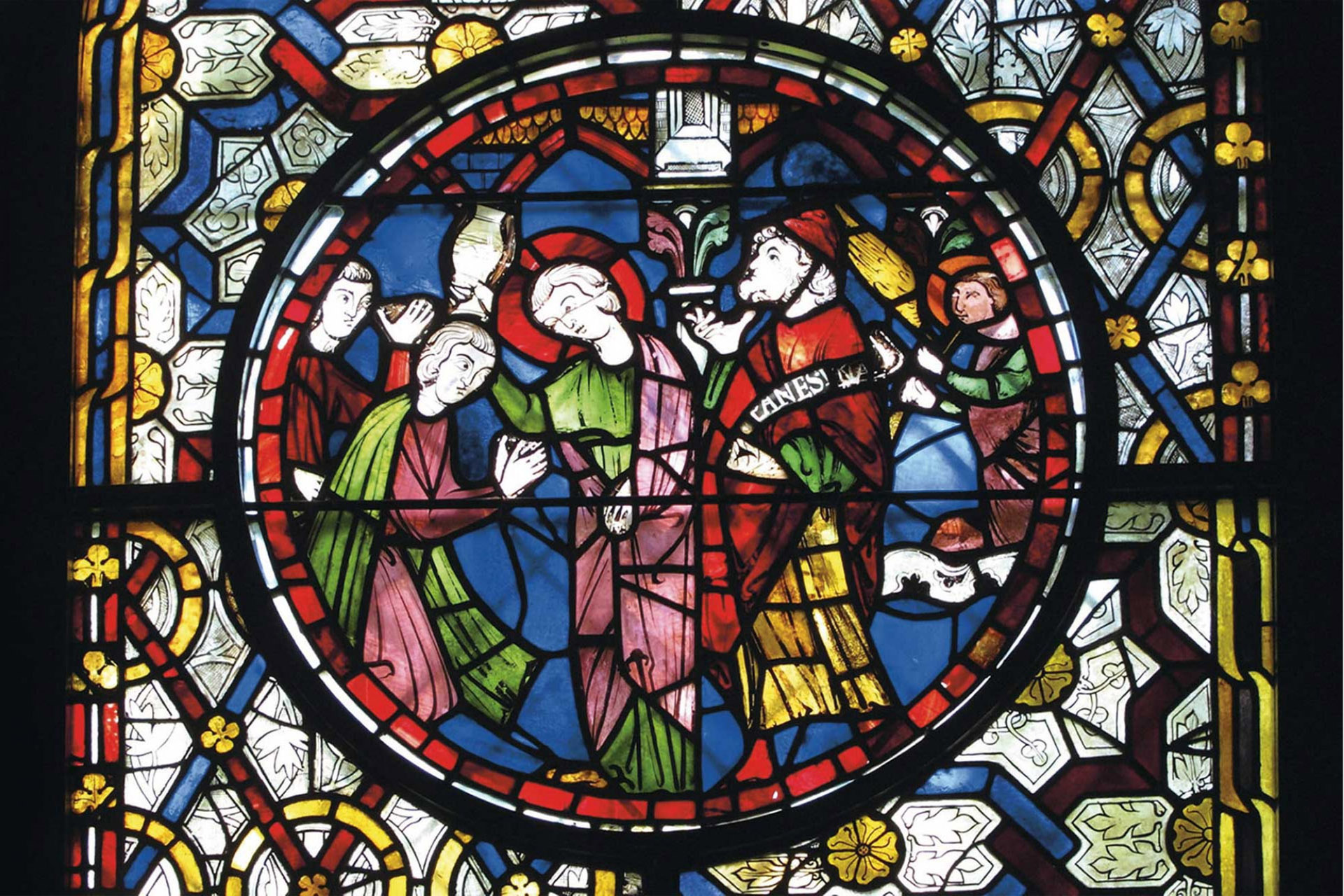Cassandra Harrington | clh62@kent.ac.uk
PhD Candidate, Centre for Medieval and Early Modern Studies, University of Kent
After a rare opportunity, and successful auction bid in July 2018, the Lyghfield Bible has once again returned to Canterbury. A single volume of impressive craftsmanship, textually complete, with fine Latin script and lavish illuminated initials, this so-called ‘pocket Bible’ was produced in thirteenth-century Paris before arriving in Canterbury, likely in the fourteenth century. Not only is it an exquisitely beautiful example of a medieval manuscript, but an absolute treasure trove of cultural and historical value to the city.
On the afternoon of 4th March 2019 academics and graduate students gathered at the  University of Kent for a workshop dedicated to the Lyghfield Bible, which gains its name from the sixteenth-century monk who owned it before the disbanding of the monastery at Canterbury during the Reformation. Co-organised by Kent’s own Drs David Rundle and Emily Guerry in collaboration with Canterbury Cathedral, its aim was to foster conversation and shed light on the Bible’s origins and history with short papers given by scholars from a range of institutions, and encourage the discussion of ideas and opportunities for future research.
University of Kent for a workshop dedicated to the Lyghfield Bible, which gains its name from the sixteenth-century monk who owned it before the disbanding of the monastery at Canterbury during the Reformation. Co-organised by Kent’s own Drs David Rundle and Emily Guerry in collaboration with Canterbury Cathedral, its aim was to foster conversation and shed light on the Bible’s origins and history with short papers given by scholars from a range of institutions, and encourage the discussion of ideas and opportunities for future research.
Following a very warm welcome from David and Emily, delegates were acquainted with the Lyghfield Bible by Mrs Cressida Williams (Canterbury Cathedral Library). As Head of Library and Archives, she recalled the challenging process of its procurement: from spotting the lot in a Bloomsbury auction catalogue, to the generous funding acquisitions making its purchase possible, and navigating the final task of bringing it back home to Canterbury (via a train from London) after almost 500 years away.
The first session, chaired by Dr Robert Gallagher (University of Kent), set the scene of bustling medieval Paris, with Dr Alison Ray (Canterbury Cathedral Library) contextualising the production of books in the late thirteenth century and Paris’ status as a flourishing city and international centre of learning. This was followed by Dr Emily Guerry (University of Kent) revealing similarities in iconographical trends among the Parisian illustration workshops, and Dr David Rundle (University of Kent) examining what marginal annotations might reveal (or, indeed, don’t reveal!) about the Lyghfield Bible.
Questions came in from all corners of the room, including considerations of provenance, Parisian practices of production and design, usage, literacy, scholasticism, and the interplay between image and text. Could it have been made for a successor of Archbishop Stephen Langton (d. 1228)? How ‘standardised’ are its illuminations, and was there much scope for their customisation? What do the choices of pigments used tell us? Do we have an indication of how many scribes were working on the Bible, and can this offer us a more concrete means of dating it? How does the material evidence and the cleanness of its margins inform our understanding of how the Lyghfield Bible might have been used?
The consensus places the Lyghfield Bible in the last quarter of the thirteenth century (possibly the 1290’s), though the number of scribes working on its script is at present unknown. However, the illuminations remarkably appear to be the work of a singular artist and entirety produced by one workshop. The utilisation of spectroscopy would give us more detailed and definitive information on the pigments used for illumination, but they are undoubtedly distinctive. Interestingly, it was observed that if the Bible had an initial French owner then they were not interested in leaving their mark in any way, as all evidence of marginal annotation is English in attribution.
After some much-needed fortification (in the form of tea, coffee and a selection of biscuits) the second session, chaired by Ms Roísín Astell (University of Kent), explored the context of the Lyghfield Bible’s reception in Canterbury from Paris. Getting things underway, Dr Emily Corran (University of Oxford/UCL) shed light on the tradition of Bible study at Canterbury, while Dr Claire Bartram (Christ Church Canterbury University) presented her findings on the book-culture of Canterbury and its surrounding areas. Lastly, Dr Eyal Poleg (Queen Mary University of London) had the challenging task of discussing the Lyghfield Bible’s place in the history of the Bible in England.
Exactitude in the when and how it came to Canterbury remains unknown, but an assortment of thought-provoking questions got everybody considering the Lyghfield Bible’s equally exciting ‘afterlife’ post-production, and broader aspects of identity and social status. Who would have the means and position to purchase such an elegant textual object? Was it brought over by a visiting scholar from the University of Paris? There is unfortunately no information available on book collecting, and provenance for the Lyghfield Bible in this regard remains obscure. However, interesting observations were made about its usage. Whilst almost certainly designed for personal use, issues with the nomenclature of ‘pocket bible’ were raised: indeed, for a still relatively weighty codex comprised from 590 leaves of vellum, you would need some thick-lined pockets to avoid doing yourself any damage.
After the workshop, delegates made their way down the hill to Canterbury Cathedral for a  wonderful opportunity to see the Lyghfield Bible up close in person, and marvel at its size and beauty – a very special treat! The day culminated with a brilliant Annual Archives and Library Lecture entitled ‘Illuminating The Bible in Medieval Canterbury’ by Dr Alixe Bovey (The Courtauld Institute, London), and a celebratory glass (or two) at the drinks reception. The day was not only thoroughly enjoyable for those involved, but also a great success. Animated discussion on the life of the Lyghfield Bible, from its origin in thirteenth-century Paris to its time in Canterbury through the Early Modern period to the present day, explored fresh new perspectives and encouraged the possibility for future interdisciplinary and institutional collaboration. It also facilitated the opportunity for experts across a range of periods and disciplines to meet and reflect on what we know, do not know, and might yet know about the Lyghfield Bible. One thing is for certain, however: the Lyghfield Bible has an enticingly enigmatic past, and holds an equally exciting future, here in the city of Canterbury.
wonderful opportunity to see the Lyghfield Bible up close in person, and marvel at its size and beauty – a very special treat! The day culminated with a brilliant Annual Archives and Library Lecture entitled ‘Illuminating The Bible in Medieval Canterbury’ by Dr Alixe Bovey (The Courtauld Institute, London), and a celebratory glass (or two) at the drinks reception. The day was not only thoroughly enjoyable for those involved, but also a great success. Animated discussion on the life of the Lyghfield Bible, from its origin in thirteenth-century Paris to its time in Canterbury through the Early Modern period to the present day, explored fresh new perspectives and encouraged the possibility for future interdisciplinary and institutional collaboration. It also facilitated the opportunity for experts across a range of periods and disciplines to meet and reflect on what we know, do not know, and might yet know about the Lyghfield Bible. One thing is for certain, however: the Lyghfield Bible has an enticingly enigmatic past, and holds an equally exciting future, here in the city of Canterbury.
